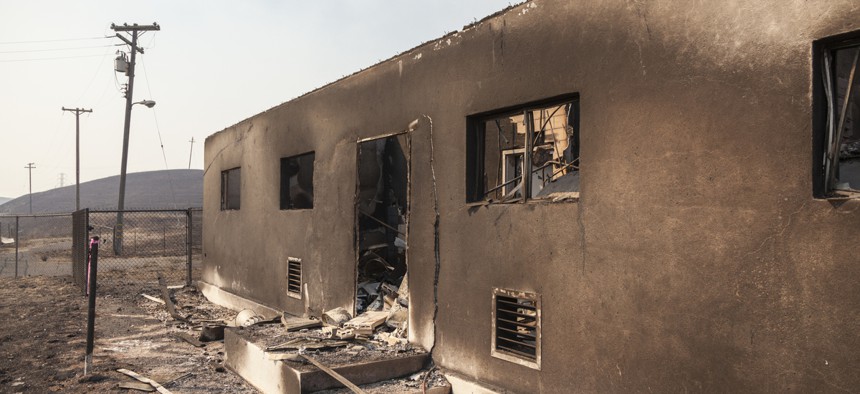Class-Action Lawsuits Could Pressure Utilities to Update Practices Following Wildfires

Burned remains of the 100-year-old Stornetta Dairy complex, east of Sonoma, California, in October 2017. Shutterstock

Connecting state and local government leaders
Southern California Edison faces litigation and is accused of negligence following the largest fire on record in the Golden State.
The class action suit filed earlier this month against Southern California Edison is sure to amplify calls to bolster protections against sparking power lines across wildfire-prone western states.
Nine plaintiffs accused the utility of negligently igniting the Thomas Fire, the largest wildfire in California history. The suit claims the electric utility undertook “unsafe” construction work and that it had performed inadequate line and equipment maintenance, including failing to remove vegetation and brush adjacent to power lines and poles.
The Thomas Fire roared to life Dec. 4 in the hills near Santa Paula, about 70 miles northwest of downtown Los Angeles and burned for weeks, incinerating more than 270,000 acres of land in Santa Barbara and Ventura counties. The fire racked up more than $120 million in damages, displaced more than 100,000 residents and has been blamed for two deaths, including the death of one firefighter. Ash from the fire clouded skies and covered ground across hundreds of miles. The burn zone, now barren of vegetation, faces a heightened risk for mudslides and debris flows during winter rains. Some vulnerable areas are now under evacuation orders.
At a community meeting held the week before Christmas, residents of the Santa Paula and Ojai areas recalled what they thought was an electricity transformer exploding on the night the fire started, according to the Santa Barbara Independent.
“We heard a huge explosion about 30 or 50 feet outside of our window,” said Ojai homeowner Tiarzha Taylor… “We turned and looked and saw sparks falling to the ground and our yard catching on fire… I ran to get the kids out of there and called 9-1-1.”
Taylor’s children said they heard an electrical buzzing sound outside that made them look out the window. “I heard this buzzing ‘zzzzzz’ sound, kind of like what you might hear in a movie about a mad scientist,” said Cole Everett, age 12. “The sound was dragged out and pretty loud. Then I saw a huge flash of light at the pole, and heard a boom, and saw a sprinkling of sparks falling to the ground.” The buzzing sound was also heard by Darren Hawkins, another Koenigstein Road resident who lost his home in the blaze.
The Thomas Fire litigation follows similar lawsuits filed following this past October’s large wildfires in Northern California’s wine country. CalFire, the state’s fire protection agency, has launched official investigations into the role utilities may have played in igniting the blazes there and in Southern California.
As Route Fifty reported last month, some experts have ramped up calls for utilities to quickly and widely adopt fairly simple and relatively inexpensive practices already in use in places like San Diego—practices that use advanced weather modeling to accurately determine when to shut off power to lines and transformers likely to be whipped by gusting winds in order to prevent them from falling and surging and sending sparks into hot and dry brush.
“Surging power lines ignite these fires,” Cliff Mass, a professor of atmospheric sciences at the University of Washington and a popular weather blogger, told Route Fifty. “It's one of the solvable problems that people aren't addressing. Municipalities have significant regulatory powers over utilities. I think they could require change.
“Cutting power temporarily in a fire-prone section of a county is going to be a much cheaper solution than burying all the power lines,” he said.
John Tomasic is a journalist based in Seattle.

NEXT STORY: How Do New 'Supertall' Skyscrapers in U.S. Cities Measure Up to the Rest of the World?




